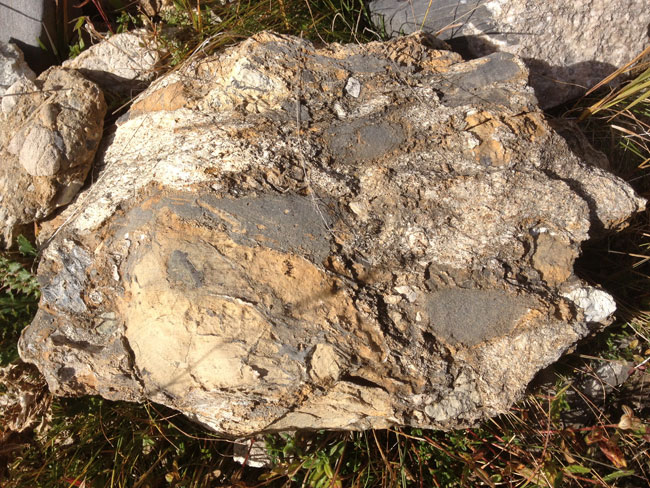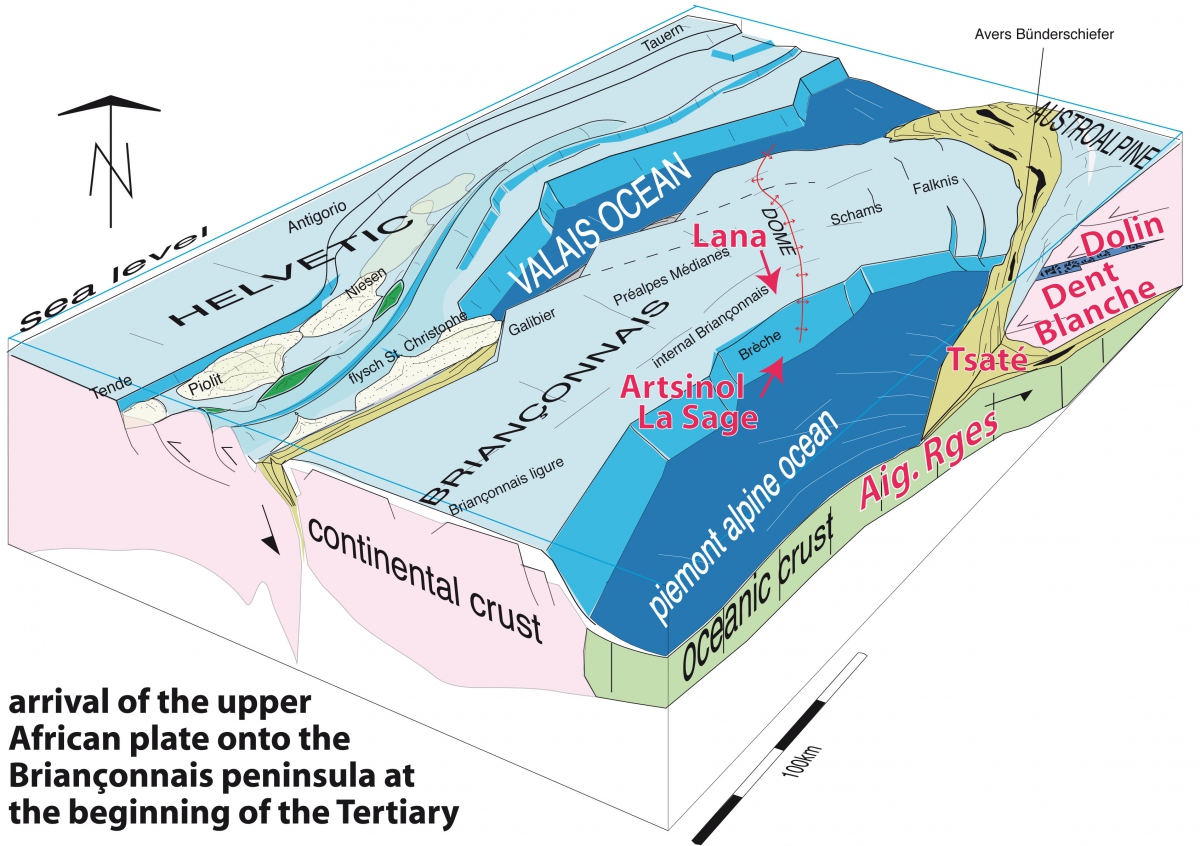A rift in the Alps
These rifts created large fault escarpments from which rock debris were produced, called breccias. In the Val d’Hérens, breccias from both sides of the Alpine Rift are found, in Mont Dolin for the southern margin, and around the Pic d’Artzinol for the northern margin. Tens of thousands of Ma later, these rift margins became continental margins making the transition from the continent to the ocean. A thick series of sediments accumulated on these margins until the Tertiary, followed by the subduction of most of the margins in Valais under the African plate.
During the rifting process the continental crust breaks into massive blocks which slide against each other and tilt like domino. Sedimentary basins develop on these tilted-blocks, made of thick layers of rift shoulder debris, and characteristic of this period. Climate permitting, small coral reefs and salt and gypsum deposits can be found, as for example in the Red Sea.
Rift shoulders are raised several kilometres high as in the Vosges and Black-Forest massifs. This is due to thermic expansion due to rising hot rocks from the asthenosphere that causes also volcanism. This is why rifts are encircled by mountain chains (but not of alpine type), as is the case in the Red Sea region with summits reaching 3000 metres.
The Alpine Rift is predominately characterised by breccia deposits made of older rock debris (blue and yellow in the figure) originating from Triassic to Jurassic rocks that were deposited just before the opening of the Alpine rift.
The largest breccia deposits are on the tilted block closest to the rising rift shoulder. Finer debris fill in the more distant blocks. These debris flows or avalanches, called turbidite, mainly occur on the sea floor, with coarser elements being deposed first, and finer ones travelling long distances across the developing sea floor.Further reading:

The Triassic pre-rift is constituted by a defined series of rocks: quartzite at the base, followed by limestone, and at the top dolomites, or limestone with magnesium. These dolomites characterise the Alpine Triassic and are not present in older or younger alpine strata. They are easily recognisable by their yellow colouring, and unlike limestone, do not react to diluted hydrochloric acid.
The photo of the Mont Dolin breccia show 10 to 20 centimetres long blocs of yellow dolomite associated with white and grey Triassic limestone.

The Val d’Hérens is exceptional in that it contains breccias from both the southern alpine, or African margin, at Mt Dolin, and from the northern European margin, around the Pic d’Artsinol and Villa. These two regions represent what is left of the Jurassic rift during the Alpine Ocean opening, 180 Ma ago. Much later, during the collision of the plates, the northern European margin slid under the southern African margin, making a lower and upper plate. The colliding continental margins underwent many transformations leading to their destruction. The African upper plate was raised when passing over the lower European plate, and severely eroded for millions of years. The European margin however was buried tens of kilometres deep. Only few fragments escaped this process and are visible as in the Val d’Hérens. The exceptional breccias around Mt Dolin for example are the only remnants of the upper plate, surviving the intense erosion of the western Alps. The Pic d’Artsinol breccias are also relatively unique although during the collision some were transported to form the Brèche Nappe in the Fribourg and Chablais Prealps.
NB: As a large part of the northern margin sediments was detached from its substratum in Valais, and transported far northward (see chapter Alpine tectonics), a study of the Prealps enables a better understanding of the geological changes in the Alps. Rocks from the Prealps were preserved from the process of metamorphism and, still rich in fossils, allow the determination of their age, something not possible with the metamorphic rocks from Valais.
During the widening of an ocean, the rift shoulders and tilted blocks become the continental margins of the ocean. Moving away from the hot mid-oceanic ridge, these margins cool and densify, passing under sea level. They are then progressively covered by thousands of meters of marine sediments. As mentioned, these mostly disappeared sediments south of the Rhone can be studied in the Prealps.
The rift sediments are then covered by a thick, mainly limestone series deposited between the Middle Jurassic and the Tertiary eras. During these 130 Ma the northern Valais margin became a passive margin, with only sedimentation occurring. The onset of a future collision is suddenly apparent with the arrival of terrigenous sediments derived from the erosion of the African plate. These sediments have enabled a precise dating of the subduction of the northern margin under the southern during the Eocene (Lutetian), 40 Ma ago, as shown in the figure (modified from Luzieux and Ferrari 2002).

















